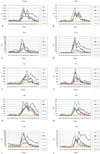Abstract
The pandemic influenza (H1N1 2009) virus, after being introduced in Korea in April, 2009, spread rapidly nationwide in mid-2009. This study was conducted to characterize trend in age distribution of visitors to Flu-clinics during the pandemic. Demographic, clinical and laboratory data of visitors to flu clinic from Week 36 to 52 (August 30 to December 26) of 2009 were retrieved and collected from electronic databases at 9 hospitals. Visitors 0-6, 7-12, 13-18, 19-29, 30-64, and 65 years or more of age were classified into group I to VI, respectively. A total of 107,467 visitors were seen at Flu-clinics for a 17-week study period. Of those, 32,485 were laboratory-confirmed. Antivirals were prescribed for 62,533 visitors. Numbers of visits, prescriptions of antivirals, and laboratory-confirmed cases of the pandemic influenza (H1N1 2009) peaked at Week 44. A large number of visits by group II and III were followed by those of group I and V, especially around the peak. Numbers of visits by group VI were lowest in all hospitals. In some hospitals, higher number of visits lasted longer in children than in adults while vice versa in other hospitals depending on the location. In summary, the pandemic influenza (H1N1 2009) was presumed to peak in late October and involved majorly children and students in Korea. Unique age distribution of visitors to flu clinic was observed in some hospitals.
Figures and Tables
Figure 1
Summary of visits to flu clinic at 9 hospitals from Week 36 to 52 of 2009. (A) Total numbers of visits to flu clinic (Visit), prescriptions of antivirals (Rx), and laboratory-confirmed cases of 2009 pandemic influenza (H1N1 2009) (RTPCR+) in 9 hospitals. (B) Numbers of visits to flu clinic at each hospital. (C) Numbers of laboratory-confirmed cases by week according to age group. Group I to VI represents visitors 0-6, 7-12, 13-18, 19-29, 30-64, and 65 years or more of age, respectively.

References
1. Centers for Disease Control and Prevention (CDC). Outbreak of swine-origin influenza A (H1N1) virus infection - Mexico, March-April 2009. MMWR Morb Mortal Wkly Rep. 2009. 58:467–470.
2. Novel Swine-Origin Influenza A (H1N1) Virus Investigation Team, Dawood FS, Jain S, Finelli L, Shaw MW, Lindstrom S, Garten RJ, Gubareva LV, Xu X, Bridges CB, Uyeki TM. Emergence of a novel swine-origin influenza A (H1N1) virus in humans. N Engl J Med. 2009. 360:2605–2615.

4. Kim WJ. Pandemic of novel influenza A (H1N1): Perspective and countermeasures. Korean J Med. 2009. 77:139–142.
5. Kim WJ. Novel influenza A/H1N1 pandemic: current status and prospects. J Korean Med Assoc. 2009. 52:787–794.

6. Kim WJ. Epidemiologic and clinical characteristics of pandemic influenza (1918~2009). Infect Chemother. 2009. 14:Suppl 2. S121–S128.
7. Korea Centers for Disease Control and Prevention. Current status of selected infectious diseases. Public Health Weekly Report. 2009. 2:886.
8. Lee DH, Shin SS, Jun BY, Lee JK. National level response to pandemic (H1N1) 2009. J Prev Med Public Health. 2010. 43:99–104.

9. World Health Organization. Preliminary informat ion important for understanding the evolving situation : Pandemic (H1N1) 2009 briefing note 4. Accessed 23 April 2010. Available at: http://www.who.int/csr/disease/swineflu/notes/h1n1_situation_20090724/en/index.html.
10. Nishiura H, Castillo-Chavez C, Safan M, Chowell G. Transmission potential of the new influenza A(H1N1) virus and its age-specificity in Japan. Euro Surveill. 2009. 14:pii:19227.

11. Korea Centers for Disease Control and Prevention. Acute infectious agents laboratory surveillance reports (weekly): Week 52 of 2009. Accessed 23 April 2010. Available at: http://cdc.go.kr/kcdchome/jsp/home/common/brd/COMMBRD0200Detail.jsp?boardid=1556&boardseq=22&menuid=101972&appid=null&contentid=null&pageNum=2&pageNo=2&q_value=&q_name=&sub=6.
12. Centers for Disease Control and Prevention(CDC). Update: novel influenza A (H1N1) virus infection - Mexico, March-May, 2009. MMWR Morb Mortal Wkly Rep. 2009. 58:585–589.
13. Centers for Disease Control and Prevention (CDC). 2009 pandemic influenza A (H1N1) virus infections - Chicago, Illinois, April-July 2009. MMWR Morb Mortal Wkly Rep. 2009. 58:913–918.
14. Centers for Disease Control and Prevention (CDC). Serum cross-reactive antibody response to a novel influenza A (H1N1) virus after vaccination with seasonal influenza vaccine. MMWR Morb Mortal Wkly Rep. 2009. 58:521–524.
15. Korea Centers for Disease Control and Prevention. Serologic cross-reactivity of serum samples from different age groups in Korea against a novel influenza A (H1N1) virus. Public Health Weekly Report. 2009. 2:744–745.
16. Korea Centers for Disease Control and Prevention. Influenza A (H1N1) 2009 vaccination program in Korea. Public Health Weekly Report. 2009. 2:761.




 PDF
PDF ePub
ePub Citation
Citation Print
Print





 XML Download
XML Download